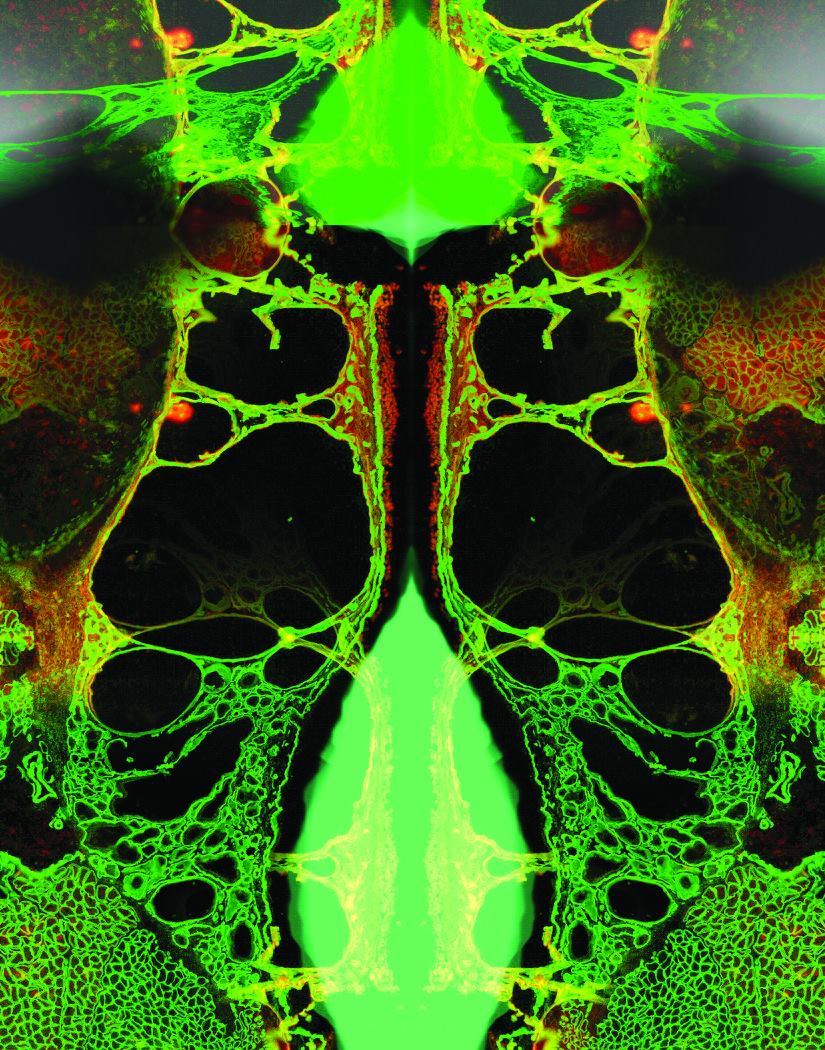Green Revolutions
Scientist Collaborator
Amy Marshall-Colon
Amy Marshall-Colon Laboratory
Instrument
Cytoscape 2.8.3
Funding Agency
Funded by the NIH
Original Imaging



Special Thanks
Subterfuge
Scientist Collaborator
Joanna Shisler and Ed Roy
Joanna Shisler Laboratory
Ed Roy Laboratory
Instrument
Axiovision image analysis
Funding Agency
Funded by the NIH
Original Imaging



Special Thanks
Light and Dark
Scientist Collaborator
Angela Bustamante
Monica Uddin Laboratory
Instrument
Illumina HT-12 Expression BeadChip; WGCNA statistical package
Funding Agency
Funded by the NIH
Original Imaging



Special Thanks
Sweet Spots
Scientist Collaborator
Berkley Walker, Elliot Brazil, Jessica Ayers, Cody Jones and Donald Ort
Donald Ort Laboratory
Instrument
Ocean Optics Jaz Spectrophotometer
Funding Agency
Funded by a subcontract from the Bill and Melinda Gates Foundation
Original Imaging



Special Thanks
Enemy Worlds
Scientist Collaborator
Jee-Wei (Emily) Chen
Brendan Harley Laboratory
Instrument
Multiphoton Confocal Microscope Zeiss 710 with Mai Tai eHP Ti:sapphire laser
Funding Agency
Funded by a subcontract from the Bill and Melinda Gates Foundation
Original Imaging



Special Thanks
Age of Aquarius
Scientist Collaborator
Alexa Sadier, Elise Lambert
Karen Sears Laboratory
Vincent Laudet Laboratory
Instrument
Leica M205 Fully Automated Fluorescence Stereomicroscope
Funding Agency
Funded by the Center National pour la Recherche Scientifique, the Ecole Normale Supérieure de Lyon, the Région Rhône-Alpes, and the Fondation ARC pour la Recherche sur le Cancer
Original Imaging



Special Thanks
The Mind that Knows Itself
Scientist Collaborator
Noëlle James
Alison Bell Laboratory
Instrument
NanoZoomer Slider Scanner
Funding Agency
Funded by the NSF, NIH, Simons Foundation, and the University of Illinois
Original Imaging



Special Thanks
Roadways
Scientist Collaborator
Si (Stacie) Chen
Princess Imoukhuede Laboratory
Instrument
Olympus IX51 inverted microscope
Funding Agency
Funded by the American Heart Association, American Cancer Society, and NSF
Original Imaging



Special Thanks
Walking on a Cloud
Scientist Collaborator
Juxing Chen
Jeffery Escobar Laboratory
Instrument
NanoZoomer Slider Scanner
Funding Agency
Funded by the NIH and Novus International Inc.
Original Imaging



Special Thanks
Inner Space
Scientist Collaborator
Abigail Asangba
Bruce Fouke Laboratory
Instrument
Zeiss Axiozoom V16 Scope
Funding Agency
Funded by the Total Oil Company
Original Imaging



Special Thanks
Flowing Silhouettes
Scientist Collaborator
Jingnu Xia
Patrick Brown Laboratory
Instrument
NanoZoomer Slider Scanner
Funding Agency
Funded by the DOE
Original Imaging



Special Thanks
Unborn Sun
Scientist Collaborator
Mayandi Sivaguru
Surangi Punyasena Laboratory
Instrument
Zeiss LSM 880 Airyscan; Imaris 3D visualization package
Funding Agency
Funded by the NSF
Original Imaging



Special Thanks
Echo Chambers
Scientist Collaborator
Charles Lenell
Aaron Johnson Laboratory
Instrument
NanoZoomer Slider Scanner
Funding Agency
Funded by the American Speech-Language-Hearing Foundation
Original Imaging



Special Thanks
Heart of the Mind
Scientist Collaborator
Christopher Seward
Lisa Stubbs Laboratory
Instrument
Multiphoton Confocal Microscope Zeiss 710 with Mai Tai eHP Ti:sapphire laser
Funding Agency
Funded by the Simons Foundation
Original Imaging



Special Thanks
Musical Family
Scientist Collaborator
Jinrong Chen
Hyunjoon Kong Laboratory
Instrument
Zeiss Stereolumar v12 microscope
Funding Agency
Funded by the NIH
Original Imaging



Special Thanks
Milestones
Scientist Collaborator
Alireza Tofangchi
Taher Saif Laboratory
Instrument
Zeiss Lightsheet Z1
Funding Agency
Funded by the NSF
Original Imaging



Special Thanks
Finding a Voice
Scientist Collaborator
Vignesh Sivaguru
Aaron Johnson Laboratory
Instrument
Multiphoton Confocal Microscope Zeiss 710 with Mai Tai eHP Ti:sapphire laser; Autoquant
Funding Agency
Funded by the American Speech-Language Hearing Foundation
Original Imaging



Special Thanks
Triton’s Tears
Scientist Collaborator
Stephanie Mager
Stephen Marshak Laboratory
Instrument
Zeiss Axiozoom V16 Scope
Funding Agency
Funded by the NSF
Original Imaging



Special Thanks
A Clear Mind
Scientist Collaborator
Christopher Seward
Lisa Stubbs Laboratory
Instrument
Multiphoton Confocal Microscope Zeiss 710 with Mai Tai eHP Ti:sapphire laser
Funding Agency
Funded by the Simons Foundation
Original Imaging



Special Thanks




























